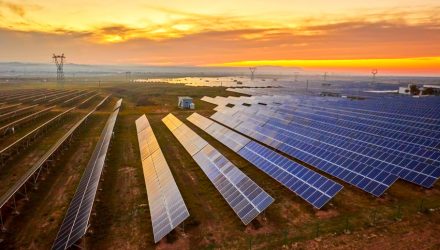Renewable energy sources, led by solar and wind, are capturing increasingly larger shares of the energy market, a trend that should benefit ETFs, such as the ALPS Clean Energy ETF (ACES), over the long-term.
As some of the past decade’s alternative energy investments start paying off, ACES has the potential to do the same. Up almost 14% over the past month, ACES is already delivering for investors.
“More than $2.7 trillion has been invested in building up renewable energy capacity over the past decade. In those same 10 years, renewables more than doubled their share of the global power mix, from 5.9% in 2009 to 13.4% last year,” reports Nathaniel Bullard for Bloomberg.
ACES follows the CIBC Atlas Clean Energy Index. That benchmark is comprised of U.S. and Canada-based companies that primarily operate in the clean energy sector. Constituents are companies focused on renewables and other clean technologies that enable the evolution of a more sustainable energy sector.
Long-Term Case for ACES
One reason ACES matters for long-term investors is that much more spending on a global basis to meet various sustainability initiatives.
“More investment is needed to meet the goals of the Paris Agreement, and governments and industry groups are touting clean-energy investment as an essential part of recovery from the Covid-19 pandemic,” according to Bloomberg.
Renewable energy or clean energy ETFs that track industries like wind and solar farms are attracting more interest among investors seeking low-risk opportunities during this volatile period. Similar to what happened during the 2008 financial crisis, investors turned to renewable wind and solar farms as a safe-harbor investment with attractive yields. Wind and solar farms have long-term contracts to sell their electrical output to utilities and companies with good credit ratings for long periods, which makes their returns stable and relatively low risk.
ACES’ components provide the products and services that enable the evolution of a more sustainable energy sector. The green energy companies are engaged in renewable energy sources, including solar power, wind power, hydroelectricity, geothermal energy, biomass, biofuels, and tidal/wave energy; clean technologies, including electric vehicles, energy storage, lithium, fuel cell, LED, smart grid, and energy efficiency technologies; and other emerging clean energy activities and technologies.
International markets matter to ACES.
“For the first time in 2015, China, India, and other developing countries invested more in clean energy than the developed world did, and there’s been no going back. Developing economies have received more than half of all dollars invested in clean energy for five years in a row,” reports Bloomberg.
Other alternative energy ETFs include the Invesco Solar ETF (NYSEArca: TAN) and the First Trust Global Wind Energy ETF (NYSEArca: FAN).
For more on cornerstone strategies, visit our ETF Building Blocks Channel.
The opinions and forecasts expressed herein are solely those of Tom Lydon, and may not actually come to pass. Information on this site should not be used or construed as an offer to sell, a solicitation of an offer to buy, or a recommendation for any product.








